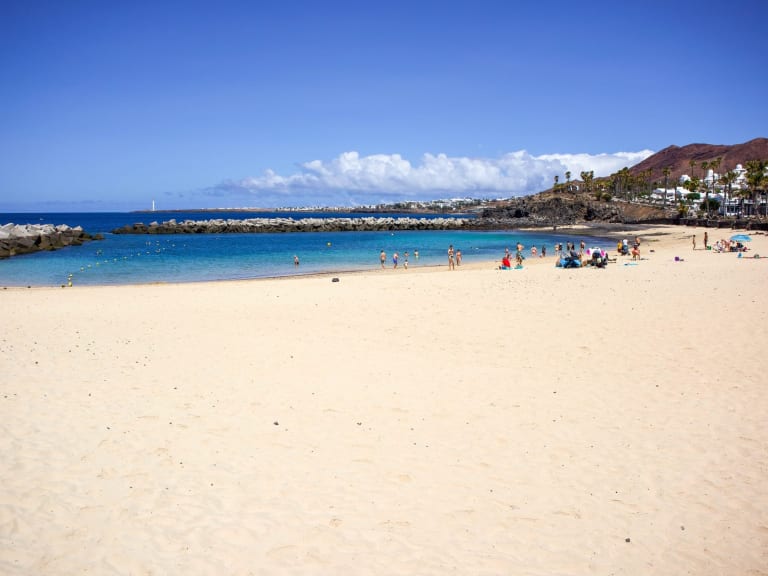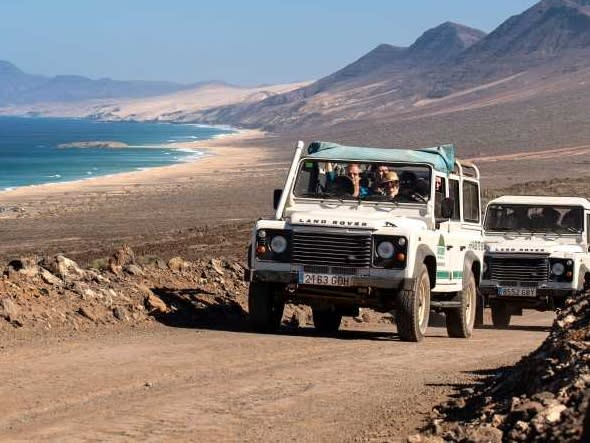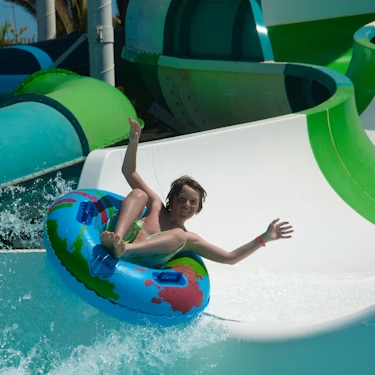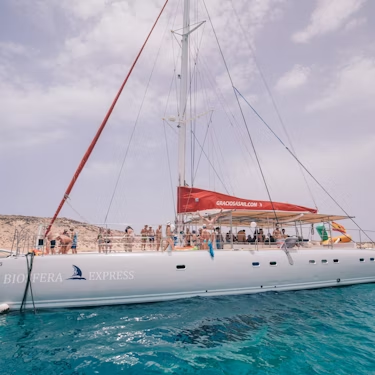More about: 5 Best Day Trips to Fuerteventura from Lanzarote
Among the islands of the archipelago, Fuerteventura is the closest to Africa. It is famous for its desert landscape, ravines and extensive beaches with a wild charm. There is a lot to see and do in Lanzarote, but the trip is very short (about half an hour) and with a guided tour you won't waste any time planning your itinerary. Here are the best ones!
1. Excursion to Fuerteventura from Lanzarote

This self-guided excursion to Fuerteventura from Lanzarote is a comprehensive tour that takes you to the island's main attractions in just over half a day.
A bus will usually pick you up from your hotel in Lanzarote. You will then cross the strait by ferry and board another bus to continue the tour in Fuerteventura. The main stops are:
- Aloe Vera Farm, where this precious plant with thousands of beneficial properties is grown. It is very hardy, as it manages to grow in an environment that is hostile to most vegetation.
- Goat cheese farm. Although Majorera goats live on all the islands of the archipelago, they are native to Fuerteventura. Their milk is used to make a cheese with Designation of Origin, which stands out for its slightly sour and spicy flavour. You will visit a traditional farm and have the opportunity to taste some types (in some cases accompanied by a glass of white wine).
- Betancuria, the town founded by the Frenchman Jean de Bethencourt. Its origins date back to 1404, when a first expedition arrived in Fuerteventura from Normandy. One of the first buildings they erected was the Church of Santa María. Today it is one of the most beautiful villages on the island.
- Mirador de los Reyes, a panoramic viewpoint with statues of Ayose (King of Jandía) and Guise (King of Maxorata). Before the arrival of the Spanish, they divided power in Fuerteventura.
- Pájara, a tiny village in the south of Fuerteventura. Its icon is the Church of the Virgen de la Regla, a temple decorated with iconographic elements apparently inspired by Aztec art. A real mystery...
- Antigua, perhaps the most beautiful town on the island. In addition to its perfectly preserved old town, it is known for the Castillo de Fuste on the coast.
- Puerto del Rosario. Before returning to Corralejo, the routes usually pass through this town, which is the largest on the island. It is also the capital and offers a wide range of leisure activities
After leaving Puerto del Rosario, the bus will take you to the Corralejo Dunes. As the name suggests, these are high sand dunes that characterise the landscape. The site is much loved by film directors and surfers alike. The waves and wind are always strong. At the end of the stage, take the ferry back to Playa Blanca.
Practical information
- Duration: approximately 7 hours
- Price: — from £38
2. One-day off-road excursion in Fuerteventura

In such an extreme environment as Fuerteventura, an off-road vehicle is the ideal means of transport. You can leave the paved roads behind and get up close to the wild side of the island.
These routes usually start with a bus that picks you up at your hotel in Lanzarote (or a nearby location) and takes you to the port of Playa Blanca.
Groups are usually made up of a maximum of 8 people, and the off-road vehicles visit the following points:
- Volcanoes. In the north of Fuerteventura are the craters of Bayuyo and Calderón Hondo
- La Oliva, the former capital of the island. Its most emblematic buildings are the Church of Nuestra Señora de la Candelaria and the Casa del Inglés, the remains of a former residence of the agricultural bourgeoisie.
- Tindaya, the sacred mountain. In the past, magical-religious rituals and rock carvings called podomorfos were performed here. The orientation of the mountain allows the growth of plant species such as the cuernúa or "dog's tooth". The off-road vehicles climb to the summit from the village of the same name, located at the foot of the mountain
- El Cotillo, a fishing village that is becoming a new tourist destination in Fuerteventura. Its landmarks are the lighthouse and the Castillo del Tostón, both on the coast. A stop is planned near Los Charcos, a series of natural pools in the northern part of the village
The price includes lunch at a traditional restaurant. At the end of the experience, the driver will take you back to Corralejo where you will catch the ferry to Lanzarote.
Practical information
- Duration: between 3 and 4 hours
- Price: around £25
3. Excursion to Lobos Island and Corralejo from Lanzarote

The Islet of Lobos is located between Punta del Papagayo and the north coast of Fuerteventura. It covers a small area (less than 5 square kilometres) and is a simply wonderful place.
Its most famous spot is Concha Beach, which is crescent-shaped and characterised by shallow, crystal-clear waters.
It's a perfect place if you're travelling with children, as they can play safely or try their hand at snorkelling. By the way, if you're looking for activities for younger children, I recommend reading the post on 10 things to do in Lanzarote with children.
To get here, you'll need to take a ferry from Playa Blanca to Corralejo and then a water taxi to Lobos Island.
Don't worry, all these transfers are included in the total price (including a bus from your hotel to the port of Playa Blanca).
Practical information
- Duration: around 6 hours
- Price: between £50 and £60
4. Buggy Safari excursion in Fuerteventura from Playa Blanca

The Corralejo Dunes Natural Park is a typical desert postcard: high hills of fine sand that end at the ocean.
The excursion starts in Playa Blanca, in the south of Lanzarote. After disembarking at the port of Corralejo, an air-conditioned vehicle will take you to the park. As this is a protected area, you are not allowed to climb the dunes, but you will have time to take some panoramic photos.
The buggy routes usually start a few kilometres further on and pass through rural areas and the volcanic area of Villaverde. This vehicle is at its best on rough terrain: the lightweight chassis and large tyres guarantee a fun and adrenaline-filled ride.
Before the experience ends, there is usually a final stop in the village of Parque Holandés. Here you will have the opportunity to sample some tapas.
You can also enjoy an activity of this type without having to go to Fuerteventura. In this case, I recommend reading the post about buggy tours in Lanzarote.
Practical information
Duration: 10 hours
- Duration: 10 hours
- Price: just over £100
5. Guided e-bike tour in Fuerteventura

In 2009, the island of Fuerteventura was declared a Biosphere Reserve by UNESCO. In addition to surfing, Fuerteventura is famous for its extreme landscapes, with large desert areas swept by winds from the Sahara. An electric bike or e-bike is the perfect way to see it.
You don't need to be an expert mountain biker to go on this tour, as the assisted pedalling is a great help, but it is advisable to be used to riding on dirt tracks (and in some cases sand).
After taking a ferry from the south coast of Lanzarote, you will arrive at Corralejo, a tourist destination known for its nightlife, water sports and dunes, a real desert that ends at the ocean.
From there, a guided route of about 45 kilometres starts, passing through the following towns:
- Bayuyo Volcanoes, a group of volcanic cones that follow a straight line
- Calderón Hondo, the most famous volcano in Fuerteventura. Accessing its crater is quite easy and once there you can enjoy a view that stretches as far as Lanzarote and Lobos Island. By the way, if you love nature walks and volcanoes, I recommend reading the article on the best tours in Timanfaya
- El Cotillo, a typical fishing village. A stop is planned here so you can enjoy a refreshing swim. If you're feeling hungry, you can grab a bite to eat at Chiringuito el Muellito (Calle Gran Canaria 86) or other nearby bars
After the break, we will head back to Corralejo along the north coast. You will pass natural beaches such as Majanicho and Bajo de la Burra. Once at the port, all that remains is to take the ferry back to Lanzarote.
Practical information
- Duration: 10 hours or a little more
- Price: around £80 (includes return ferry trip)
Can I go to Fuerteventura on my own?

Yes, a regular ferry service connects the two islands. You can book your ferry ticket to Fuerteventura from Lanzarote from around £19
With four daily departures and a journey time of just half an hour, this service allows you to travel between the islands in comfort, with the flexibility to choose the timetable that best suits your plans. On board, you can enjoy the journey from inside the ship or from the open-air deck, as well as sharing the moment with your friends thanks to the included WiFi connection.
Once you arrive in Fuerteventura, you will have complete freedom to explore the island at your own pace. From turquoise beaches to charming, historic villages such as Betancuria, this Canary Island has so much to discover. Remember to go to the ticket office at least 15 minutes before departure to collect your ticket with your ID card or passport, and get ready for a day full of landscapes, culture and sea.
What are the advantages of taking a guided tour vs visiting Fuerteventura on my own?

Lanzarote and Fuerteventura are separated by a narrow stretch of sea. If your hotel, B&B or rental home is in the southern area, getting to the other side is quite easy.
However, if you are staying in Arrecife or in the north of Lanzarote, it is more complicated and an organised excursion is a recommended option.
The bus usually picks you up at your accommodation and takes you to the port of Playa Blanca. There you take a ferry to Corralejo (the main destination). In addition, the economic factor is relevant. Packages guarantee low prices and often include lunch.
Can I travel from Lanzarote to Fuerteventura by car?

It depends. If you have a rental car, in most cases you will not be able to do so. Normally, agencies do not allow transfers between islands.
There may be exceptions, but I recommend checking when you make your reservation. However, if you are travelling with your own car, this is not a problem.
What is there to do in Corralejo?

Corralejo is the main tourist destination in Fuerteventura and, in many cases, excursions allow a little time to explore it on your own. Here are a few suggestions to help you enjoy this part of your trip:
- Fish market: it has been recently renovated and has a bar that serves dishes made with very fresh fish. You'll recognise it by the drawings on the outside depicting turtles and other sea creatures (Avenida Marítima s/n).
- Beaches: as you can't stray too far from the centre, you can enjoy the beaches of Vista Lobos, Medio and Las Clavelinas.
- Tapas: some of the best bars include Land of Freedom (Avenida Nuestra Señora del Carmen - Las Palmeras Shopping Centre), Kactus Café (Calle La Iglesia 16), 13 Bistrot & Tapas (Calle La Iglesia 13) and Tuxedo (Avenida Nuestra Señora del Carmen - Las Palmeras Shopping Centre).
- Aloe vera: produced in the archipelago, there are usually stalls near the beaches in Corralejo. You can buy gels, soaps, creams and much more.














